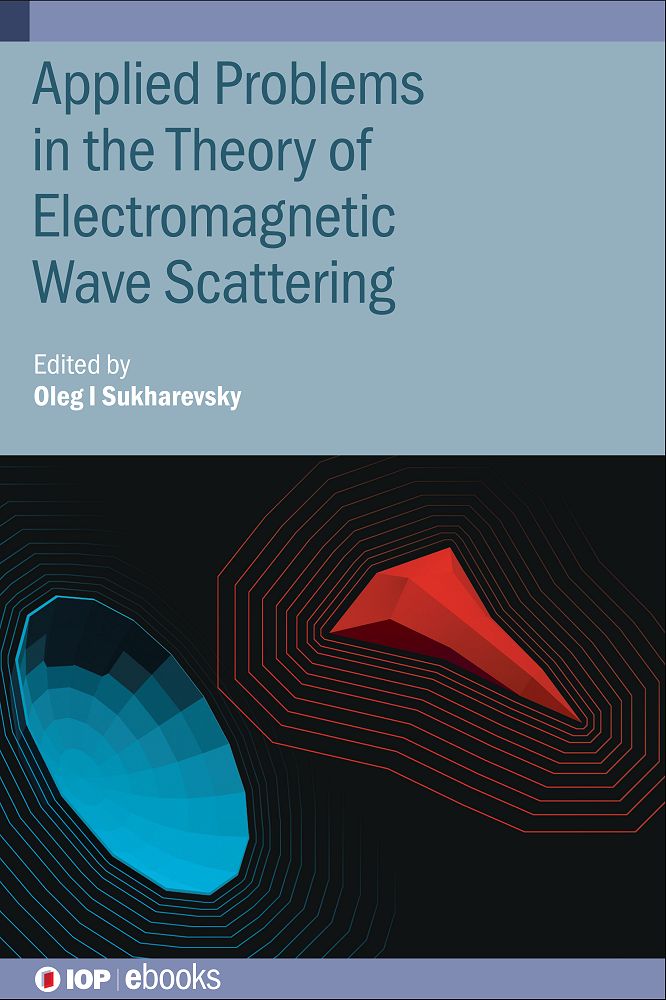
Electromagnetic Scattering Group
&
Professor Oleg I. Sukharevsky
present
the series of books with open access
(almost all books)

Electromagnetic Wave Scattering by Aerial and Ground Radar Objects
Edited by professor O. Sukharevsky
Authors: Sergey V. Nechitaylo, Valery M. Orlenko, Oleg I. Sukharevsky, Vitaliy A. Vasilets
Year: 2014
To download this book go to Taylor&Francis Group site or CLICK HERE.
Book presents the theory, original calculation methods, and computational results of the scattering characteristics of different aerial and ground radar objects. This must-have book provides essential background for computing electromagnetic wave scattering in the presence of different kinds of irregularities, as well as
- Summarizes fundamental electromagnetic statements such as the Lorentz reciprocity theorem and the image principle
- Contains integral field representations enabling the study of scattering from various layered structures
- Describes scattering computation techniques for objects with surface fractures and radar-absorbent coatings
- Covers elimination of "terminator discontinuities" appearing in the method of physical optics in general bistatic cases
- Includes radar cross-section (RCS) statistics and high-range resolution profiles of assorted aircrafts, cruise missiles, and tanks
Complete with radar backscattering diagrams, echo signal amplitude probability distributions, and other valuable reference material, the Book is ideal for scientists, engineers, and researchers of electromagnetic wave scattering, computational electrodynamics, and radar detection and recognition algorithms.
Contents
Preface
Introduction
1. Elaboration of Scattering Electrodynamics Theory: Studying Secondary Radiation from Radar Targets
1.1 Generalization of Lorentz Reciprocity Theorem onto the Case of Fields Corresponding to Different Material Filling of a Region in Space
1.2 Application of Generalized Lorentz Reciprocity Theorem to Obtaining Integral Representations of Scattered Field Disturbances Introduced by Radio Transparent and Radar Absorbent Layered Structures
1.3 Generalized Image Principle and Its Application to Solving Some Electromagnetic Wave Scattering Problems
1.3.1 Generalized Image Principle
1.3.2 On the Influence of Underlying Surface onto the Scattering Properties of a Target
1.3.3 Calculation of Field Excited by Radiating Aperture in Presence of Arbitrary System of Scatterers
1.4 Regularization of Solutions to Nonstationary Scattering Problems in Case of Physical Optics Approximation in Bistatic Radar
1.4.1 Surface Integral Asymptotic Given Arbitrary Type of Nonsingular Stationary Phase Point and Singular, at the Edge Contour, Amplitude Function
1.4.2 Impulse Response of Perfectly Conducting Smooth Convex Body in Bistatic Radar (Physical Optics Method). Elimination of Terminator Discontinuities
1.5 Remarks on Reciprocity Principle for the Scattered Fields in Physical Optics Approximation
1.6 RCS of Three-Dimensional Objects and Its Relation to the RCS of Two-Dimensional Objects.
2. Methods for Computing Scattering Characteristics of Complex-Shaped Objects
2.1 Surface Geometry Modeling for the Complex-Shaped Objects
2.2 Method for Computing Scattering Characteristics of Aerial Objects with Imperfectly Reflecting Surface
2.2.1 Radar Scattering at Smooth Parts of the Object's Surface
2.2.2 Cubature Formula for Computing Surface Integrals of Fast Oscillating Functions
2.2.3 Asymptotic Method for Computing Radar Scattering from Smooth Parts of the Object in Bistatic Radar Case
2.2.4 Radar Scattering at the Local Edge Fractures Covered with Absorbent
2.2.5 Verification of Methods for Computing Scattering Characteristics of Simple Shape Objects
2.2.5.1 Comparison of RCS Computation Results with the Data Observed in an Anechoic Chamber
2.2.5.2 RCS Computation Results for the Cylinder Obtained Using Different Computation Methods
2.2.5.3 RCS Computation Results for the Cone-Sphere Object Obtained Using Different Computation Methods
2.2.6 RCS Computation for the Cruise Missile Model
2.2.7 RCS Reduction of the Complex-Shaped Object by Means of Optimal Distribution of Limited RAM Supply over Its Surface
2.2.8 Reduction of the Radar Scattering Level from a Local Edge Scatterer by Optimizing Its Shape
2.3 Method for Computing Scattering Characteristics of Ground Complex-Shaped Objects
2.3.1 Plane Electromagnetic Wave Scattering at Perfectly Conducting Object Placed in the Vicinity of Homogeneous Half-Space
2.3.2 Scattering Characteristics of Perfectly Conducting Model of a Ground Object
2.3.3 Method for Computing RCS of Ground Object with Nonperfectly Reflecting Surface
2.3.4 Scattering Characteristics of Nonperfectly Reflecting Model of a Ground Object
2.4 Scattering Characteristics of Reflector Antenna Systems
2.4.1 Computation of Scattering Characteristics of Electrically Large Antennas and the Measures for Reducing Their Radar Visibility
2.4.1.1 Basic Mathematical Expressions for Computing Electromagnetic Field Scattered from Electrically Large Reflector Antenna with RAM Coating at Its Rim
2.4.1.2 Study of the Possibility to Reduce RCS of Reflector Antennas by Means of Applying Radar Absorbent Coating to the Reflector Rim
2.4.2 Radar Scattering of Three-Dimensional Model of Onboard Reflector Antenna under the Cone Radome
2.5 Approximation of Smoothed Impulse Response for Objects Illuminated by Signals Occupying Certain Frequency Bands
3. Scattering Characteristics of Some Airborne and Ground Objects
3.1 Scattering Characteristics of Airborne Objects
3.1.1 Scattering Characteristics of B-2 Strategic Bomber Aircraft
3.1.2 Impulse Responses of B-2 Strategic Bomber Aircraft
3.1.3 Scattering Characteristics of Tu-22M3 Long-Range Bomber Aircraft
3.1.4 Impulse Responses of Tu-22M3 Long-Range Bomber Aircraft
3.1.5 Scattering Characteristics of Boeing 737-400 Medium-Range Airliner
3.1.6 Impulse Responses of Boeing 737-400 Medium-Range Airliner
3.1.7 Scattering Characteristics of An-26 Multipurpose Transport Aircraft
3.1.8 Impulse Responses of An-26 Multipurpose Transport Aircraft
3.1.9 Scattering Characteristics of MiG-29 Front-Line Fighter
3.1.10 Impulse Responses of MiG-29 Front-Line Fighter
3.1.11 Scattering Characteristics of F-16 Multirole Fighter
3.1.12 Impulse Responses of F-16 Multirole Fighter
3.1.13 Scattering Characteristics of AGM-86 ALCM
3.1.14 Impulse Responses of AGM-86 ALCM
3.2 Scattering Characteristics of Ground Objects
3.2.1 Scattering Characteristics of T-90 Main Battle Tank
3.2.2 Impulse Responses of T-90 Main Battle Tank
3.2.3 Scattering Characteristics of Leopard-2 Main Battle Tank
3.2.4 Impulse Responses of Leopard-2 Main Battle Tank
3.2.5 Scattering Characteristics of M1A1 Abrams Main Battle Tank
3.2.6 Impulse Responses of M1A1 Abrams Main Battle Tank
If you need more information, please contact us via email info@radar.dinos.net.



